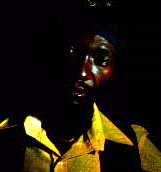 A photograph of Thomas Mapfumo from the CD The Chimurenga Singles, 1976-1980 [Shanachie 43066]. Click for recent announcements of Mapfumo's performances. [Added by GPL.]
A photograph of Thomas Mapfumo from the CD The Chimurenga Singles, 1976-1980 [Shanachie 43066]. Click for recent announcements of Mapfumo's performances. [Added by GPL.] A photograph of Thomas Mapfumo from the CD The Chimurenga Singles, 1976-1980 [Shanachie 43066]. Click for recent announcements of Mapfumo's performances. [Added by GPL.]
A photograph of Thomas Mapfumo from the CD The Chimurenga Singles, 1976-1980 [Shanachie 43066]. Click for recent announcements of Mapfumo's performances. [Added by GPL.]
The birth of Chimurenga music saw a corresponding change in Mapfumo's stage attire. He discarded the flared trousers, tight fitting T-shirts and high heeled shoes, a dress style influenced by the rock era in the 1960s. Instead he appeared on the stage bare from the waist up, wearing a loin cloth and holding a small traditional axe ('gano') His appearing on the stage holding an axe in one hand and the microphone in the other, singing 'Tumirai vana kuhondo' was a gesture which could be interpreted as identifying his music with the war of liberation. In the context the axe became a symbol of war, since the first 'chimurenga' war was fought with axes, bows and arrows. Sometimes he appeared on the stage with black and white robes also typical of spirit mediumsThe spirit of this war was believed to possess the black people during their struggle for liberation. Therefore Mapfumo's dressing then can be read as a symbolical statement of his new commitment to the liberation of the people and his faith in the ancestors guidance which he invites the audience to share with him.
[from Alice Dadirai Kwaramba, Popular Music and Society: The Language of Chiumurenga Music: The Case of Thomas Mapfumo in Zimbabwe. Oslo: University of Oslo, 1997, pages 63-64. Available from Department of Media and Communications [[email protected]].